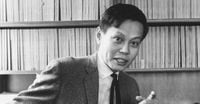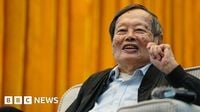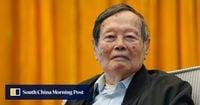Chen Ning Yang, the pioneering Nobel Prize-winning physicist whose work reshaped the foundations of modern physics, died in Beijing on Saturday at the age of 103. Tsinghua University, where Yang both studied and taught for many years, announced his passing, citing illness as the cause. The world mourns the loss of a scientist whose theories and discoveries not only broke new ground in particle physics but also bridged cultures and inspired generations.
Born on October 1, 1922, in Hefei, China, Yang’s life was shaped by both turmoil and opportunity. The eldest of five children, he grew up on the campus of Tsinghua University, where his father was a mathematics professor. As war ravaged China, the family was forced to flee to Kunming after their Beijing home was bombed in 1940—a harrowing episode that underscored the instability of the era. Yet, even amid these challenges, Yang’s intellectual gifts flourished. According to BBC, as a teenager, Yang once declared to his parents, "One day, I want to win the Nobel Prize." Remarkably, he would achieve that dream at just 35 years old.
Yang’s academic journey began at National Southwest Associated University in Kunming, where he received his science degree in 1942. He continued his studies at Tsinghua University, earning a master’s degree in 1944. After World War II, supported by a fellowship from Tsinghua, Yang traveled to the United States, enrolling at the University of Chicago. There, he came under the mentorship of Enrico Fermi, the Italian-American physicist who had overseen the world’s first nuclear reactor. Yang would later credit Fermi for teaching him that “physics is to be built from the ground up, brick by brick, layer by layer.”
Completing his doctorate in 1948 under Edward Teller, Yang spent a year teaching in Chicago before accepting a position at the Institute for Advanced Study in Princeton. It was at Princeton, under the directorship of Robert Oppenheimer, that Yang’s career truly took flight. He crossed paths with some of the greatest physicists of the age, including Albert Einstein. Reflecting on their encounter, Yang recalled, “He spoke very softly, and I found it difficult to concentrate on his words, being quite overwhelmed by the nearness of a great physicist whom I had admired for so long.”
Yang’s most celebrated achievement came in collaboration with Tsung-Dao Lee, a fellow Chinese-born physicist. In 1956, the pair challenged the long-held principle of parity conservation—a notion that physical processes should behave identically when viewed in a mirror. Their insight was sparked by puzzling behavior in the decay of the K meson, or kaon, a subatomic particle. Rather than accept the prevailing explanations, Yang and Lee proposed that the weak nuclear force, responsible for certain types of radioactive decay, might violate parity conservation. Their groundbreaking paper suggested experimental tests, and within months, Chien-Shiung Wu at the National Bureau of Standards (now NIST) confirmed their hypothesis. The results sent shockwaves through the scientific community.
In 1957, Yang and Lee were awarded the Nobel Prize in Physics, becoming the first Chinese-born laureates in the field. The Nobel committee praised their "penetrating investigation... which has led to important discoveries regarding the elementary particles." In his Nobel Banquet speech, Yang reflected on his unique position at the crossroads of East and West, stating, "I am heavy with an awareness of the fact that I am in more than one sense a product of both the Chinese and Western cultures, in harmony and in conflict." (Nobel Prize website)
Yang’s intellectual curiosity was insatiable. While at Princeton, he began collaborating with Robert Mills on what would become known as the Yang-Mills theory. This elegant mathematical framework, based on the concept of gauge symmetry, now underpins much of modern particle physics, including the Standard Model that describes the fundamental forces of nature. Yang later remarked, “At the time that we wrote it down, nobody believed that it was important and we didn’t know that it was that important, but we said that this is a beautiful idea and the mathematical structure is very elegant, so we published that paper about it. And then 20 years later, various experiments showed that that was approximately the right direction. Then after struggling for another five years, it became clear that it is not just approximately right, it is exactly right.”
Despite his scientific triumphs, Yang’s life was not without personal and professional challenges. His partnership with Lee, which produced 32 papers, eventually soured, and the two parted ways in 1962. Yang later described the split as “a tragedy.” Nonetheless, his reputation as a “pre-eminent stylist” in physics, as Freeman Dyson once put it, remained undiminished. Dyson said Yang’s “sense of mathematical beauty turns his least important calculations into miniature works of art, and turns his deeper speculations into masterpieces.”
In 1966, Yang left Princeton for Stony Brook University in New York, where he became the founding director of what is now the C.N. Yang Institute for Theoretical Physics. He retired from Stony Brook in 1999, but his influence continued to grow, especially in China. After a visit to China in 1971, Yang became a driving force in promoting basic research there. He held positions at the Chinese University of Hong Kong and, from 1999, at Tsinghua University, where he was both a professor and honorary dean of the Institute for Advanced Study.
Yang’s personal life was marked by both loss and renewal. He married Chih Li Tu in 1950, with whom he had three children. After her death in 2003, Yang, then 82, married Weng Fan, a graduate student more than 50 years his junior, whom he had first met in 1995. Yang described Weng as his "final blessing from God." (China Daily)
Citizenship was a complex issue for Yang. He became a U.S. citizen during his years in America, a decision he later described as "painful," noting that his father never forgave him for it. In 2015, Yang renounced his U.S. citizenship to become a citizen of China, encouraging other scientists to return and contribute to their homeland.
Yang’s list of accolades is long and distinguished. In addition to the Nobel Prize, he received the Albert Einstein Commemorative Award in 1957 and an honorary doctorate from Princeton University in 1958. He was a member of numerous academies and societies, and his legacy endures in the countless students and researchers he mentored.
Reflecting on the mysteries of the universe, Yang once said, “Nature is extremely subtle. I happen to think that the depth of natural substances cannot be fathomed by mankind. Because after all we only have, let’s say, 100 billion neurons. How can you match that with the infinite depth of nature?”
With Yang’s passing, the world loses not just a scientist of rare genius but a bridge between cultures, a mentor, and a relentless seeker of truth. His discoveries will echo through the halls of science for generations to come.


